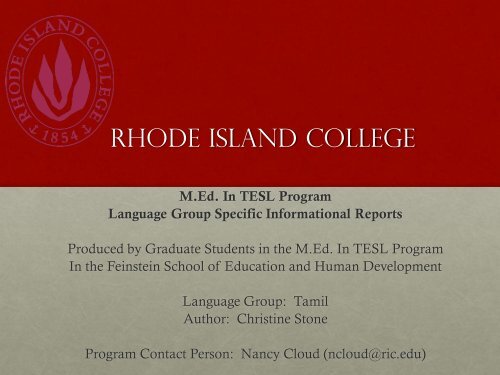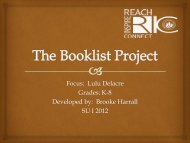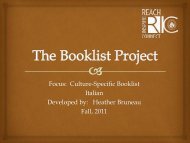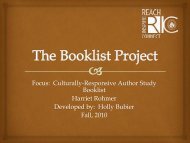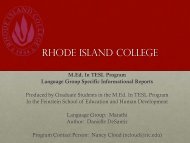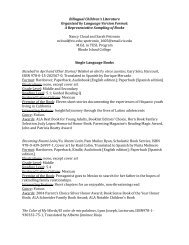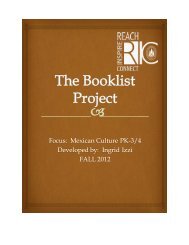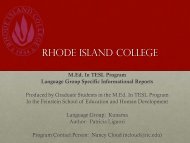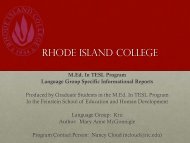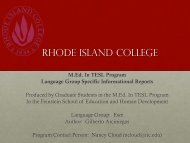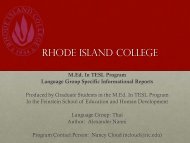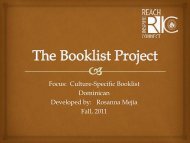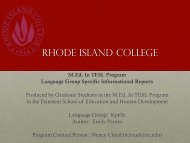Tamil - RITELL
Tamil - RITELL
Tamil - RITELL
Create successful ePaper yourself
Turn your PDF publications into a flip-book with our unique Google optimized e-Paper software.
Rhode Island College<br />
M.Ed. In TESL Program<br />
Language Group Specific Informational Reports<br />
Produced by Graduate Students in the M.Ed. In TESL Program<br />
In the Feinstein School of Education and Human Development<br />
Language Group: <strong>Tamil</strong><br />
Author: Christine Stone<br />
Program Contact Person: Nancy Cloud (ncloud@ric.edu)
Christine Stone<br />
TESL 539: Language Acquisition & Learning<br />
Spring 2012
About the <strong>Tamil</strong> Language<br />
• <strong>Tamil</strong> has a long and<br />
ancient literary tradition<br />
dating to over 2,000<br />
years ago.<br />
• <strong>Tamil</strong> is a member of the<br />
Dravidian language<br />
family, which includes<br />
thirty languages.<br />
• There are over 66 million<br />
native <strong>Tamil</strong> speakers<br />
worldwide.<br />
• 92% of <strong>Tamil</strong> speakers<br />
live in India’s southern<br />
<strong>Tamil</strong> Nadu State.<br />
• It is an official language<br />
in India, Singapore, and<br />
Sri Lanka.<br />
• <strong>Tamil</strong> has been<br />
influenced by other<br />
languages, including<br />
Sanskrit and English.<br />
(Chakraborty, 2009)
Where <strong>Tamil</strong> is Spoken<br />
• India<br />
• Northern<br />
Sri Lanka<br />
• Malaysia<br />
• Singapore<br />
• Fiji<br />
• South<br />
Africa<br />
• Great<br />
Britain<br />
• The United<br />
States<br />
• Canada<br />
• Trinidad<br />
• Guyana<br />
• Mauritius<br />
(http://tamilanhub.hubpages.com/hub/<strong>Tamil</strong>-Language)<br />
<strong>Tamil</strong> has six regional dialects:<br />
• East<br />
• West<br />
• North<br />
• South<br />
• Central<br />
• Sri Lanka<br />
(Chakraborty, 2009)
Writing System<br />
• <strong>Tamil</strong> is written in an<br />
alpha-syllabic system<br />
comparable to many other<br />
South Asian languages.<br />
• It derives from the<br />
Ashokan Brahmi script.<br />
• <strong>Tamil</strong> has 18 consonants, 12<br />
vowels, and one special<br />
character called the aytam.<br />
• The vowels and consonants<br />
combine to form 216<br />
compound characters.<br />
(www.lmp.ucla.edu)<br />
(http://c-radhakrishnan.info/alphabet.htm)
Diglossia<br />
• <strong>Tamil</strong> is a diglossic<br />
language.<br />
• The written and spoken<br />
form of <strong>Tamil</strong> are very<br />
different.<br />
• Differences include<br />
grammar, vocabulary,<br />
and pronunciation.<br />
• English learners may<br />
favor an over-elaborate<br />
or over-formal style in<br />
written English.<br />
(Chakraborty, 2009)<br />
(Swan, 2001)<br />
• Classical (Written) vs.<br />
Colloquial (Spoken) <strong>Tamil</strong><br />
• Classic <strong>Tamil</strong> is used in all<br />
writing and most types of<br />
public speech.<br />
• The written form is considered<br />
to be prestigious.<br />
• The spoken form is used in<br />
everyday conversation and<br />
informal settings.<br />
• Most variations in dialect occur<br />
in the colloquial form, varying<br />
with region and social status.<br />
(Durai & Krishnan, 2009)
Linguistic Features of <strong>Tamil</strong><br />
• <strong>Tamil</strong> has a distinctive stress pattern<br />
in which syllables with long vowels<br />
and closed syllables ended in<br />
geminated consonants bear the<br />
stress.<br />
• Speakers who have learned<br />
English from studying written<br />
texts may tend to pronounce each<br />
word as a separate unit, so that no<br />
sentence rhythm emerges.<br />
• <strong>Tamil</strong> verbs use suffixes to show<br />
person, number, mood, tense, and<br />
voice.<br />
• English learners may have<br />
considerable difficulty grasping<br />
concepts and distinctions of<br />
English, such as aspect, modality,<br />
auxiliary, adjective, adverb, and<br />
preposition.<br />
(http://www.bharatonline.com/tamilnadu/tamilnadu-photo.html)<br />
(Chakraborty, 2009)<br />
(Swan, 2001)
Language Distinctions in Phonology<br />
Vowels<br />
• <strong>Tamil</strong> speakers have difficulty<br />
distinguishing and producing the<br />
vowels in cot, caught, and coat.<br />
There are no close equivalents in<br />
<strong>Tamil</strong>.<br />
• The vowel in pat may be confused<br />
with pot or part.<br />
• Diphthongs are commonly<br />
produced as two short vowels.<br />
• paint – pe(y)int<br />
• pound – pa(w)und<br />
• Vowels may be shortened or<br />
lengthened in accordance with<br />
pronunciation patterns.<br />
Consonants<br />
• <strong>Tamil</strong> words do not usually end in<br />
consonants; therefore, learners may<br />
add a week /u/ at the ends of some<br />
English words to facilitate<br />
pronunciation.<br />
• There are no aspirated consonants.<br />
The English /p/, /t/ and /k/ are hard<br />
for learners to produce correctly and<br />
may sound like /b/, /d/ and /g/.<br />
• Pear, ten and could may be heard as<br />
bear, den, and good.<br />
• There is no /z/ in <strong>Tamil</strong>.<br />
• Maze may sound like mace.<br />
• There is no /f/ in <strong>Tamil</strong> and it may be<br />
pronounced as /p/.<br />
• Confusion between full and pull<br />
(Chakraborty, 2009)<br />
(Swan, 2001)
Language Distinctions in Syntax<br />
• <strong>Tamil</strong> lacks limited relative pronouns.<br />
• “Call the boy who learned the<br />
lesson” will be said in <strong>Tamil</strong> as<br />
“That lesson learned boy call”.<br />
• English learners may say “living<br />
next door people” instead of “the<br />
people who live next door”.<br />
• The most common sentence structure<br />
order is Subject-Object-Verb.<br />
• <strong>Tamil</strong> speakers may have difficulty<br />
understanding the ways in which<br />
English words are structured into<br />
clauses and sentences.<br />
• <strong>Tamil</strong> sentences do not always have<br />
subjects.<br />
http://en.wikipedia.org/wiki/File:<strong>Tamil</strong>_Culture.jpg<br />
(Chakraborty, 2009)<br />
(Swan, 2001)
Language Distinctions in Syntax<br />
(continued)<br />
http://cerij.wordpress.com/2011/04/08/questioning-the-question/<br />
• A <strong>Tamil</strong> sentence, however<br />
complex, only has one finite verb<br />
at most. Learners may carry this<br />
over into English, using –ing<br />
forms instead of finite verbs in<br />
subordinate clauses.<br />
• <strong>Tamil</strong> speakers may find the use<br />
of auxiliaries for questions and<br />
negatives hard to learn.<br />
• Question tags may be<br />
replaced by a single negative<br />
marker, such as “You will<br />
come, no?”<br />
Swan, 2001
Language Distinctions in Morphology<br />
• <strong>Tamil</strong> has a complex system of<br />
tenses, with meanings that do not<br />
always correspond closely to those<br />
in English.<br />
• English learners may say “In young<br />
age I play a lot” instead of “When I<br />
was young I played a lot.”<br />
• They may say “Tomorrow I will win a<br />
prize” rather than “I wish I could win<br />
a prize tomorrow.”<br />
• <strong>Tamil</strong> speakers may overuse English<br />
emphatic and reflexive pronouns.<br />
• “When he was young itself he lost<br />
his father.”<br />
• “It was he himself who stole the<br />
book.”<br />
• <strong>Tamil</strong> has no articles.<br />
• Learners may find the article<br />
system difficult. They may<br />
use one instead of a/an or<br />
may leave out the.<br />
• There is no distinction between<br />
adjectives and adverbs in <strong>Tamil</strong>.<br />
• English adjectives and<br />
adverbs may be confused<br />
with each other, or with<br />
nouns or verbs.<br />
(Chakraborty, 2009)<br />
(Swan, 2001)
Social Language<br />
• Indirect style of communication<br />
is preferred over direct.<br />
• Telling someone “no” is<br />
considered rude. In order to be<br />
polite, <strong>Tamil</strong> speakers may say<br />
“yes” to a question while<br />
bobbling their head. This<br />
usually means “no”.<br />
• <strong>Tamil</strong> speakers generally<br />
maintain a personal space of 3 to<br />
3 ½ feet during conversation.<br />
• Touching between men and<br />
women is not appropriate.<br />
• <strong>Tamil</strong>s greet each other by<br />
saying “vanakkam”. This means,<br />
“may you be blessed with a long<br />
life”.<br />
• Ears are considered sacred, so<br />
pulling or boxing one’s ears may<br />
be regarded as an insult.<br />
• Sustained eye contact is not<br />
common, especially a woman<br />
looking at a man.<br />
• Information or requests may not<br />
be expressed directly.<br />
(Chakraborty, 2009)
Cultural and Language<br />
Considerations<br />
• <strong>Tamil</strong> speakers generally pick up objects and eat only<br />
with the right hand. The left hand is considered to be<br />
unclean.<br />
• In <strong>Tamil</strong> culture, social order and status are very<br />
important. The father or oldest male is considered to<br />
be the head of household.<br />
• Answering questions with “no” to <strong>Tamil</strong> speakers may<br />
come across as rude. It is important to answer<br />
questions sensitively.<br />
• Build rapport with <strong>Tamil</strong> speakers. It is considered<br />
impolite to jump straight into business.<br />
(Chakraborty, 2009)
Cultural and Language<br />
Considerations (Continued)<br />
• <strong>Tamil</strong> speakers are often<br />
non-confrontational.<br />
• <strong>Tamil</strong> dress and culture<br />
are very conservative.<br />
• Personal honor and<br />
dignity are very<br />
important. Publicly<br />
reprimanding or<br />
criticizing a <strong>Tamil</strong><br />
speaker can be hurtful.<br />
http://panchatatva.wordpress.com/tamil-culture-and-practices/<br />
(Chakraborty, 2009)
Resources<br />
Books<br />
• Swan, M., & Smith, B. (2001). Learner English: A teacher’s guide to interference and other<br />
problems. Second Edition. Cambridge: University Press.<br />
Internet Sites and Images<br />
• Chakraborty et al. (2009). <strong>Tamil</strong> Language and Culture Guide. Retrieved<br />
February 16, 2012, from:<br />
http://languagemanuals.weebly.com/uploads/4/8/5/3/4853169/final_tamil_manual.pdf<br />
• Durai, J., & Krishnan, C. (2009). Heritage Voices: <strong>Tamil</strong>. Heritage Voices<br />
Collection. Center for Applied Linguistics. Retrieved February 21, 2012, from:<br />
http://www.cal.org/heritage/pdfs/Heritage-Voice-Language-<strong>Tamil</strong>.pdf<br />
• Question Words [Image]. (2011). Retrieved March 18, 2012, from:<br />
http://cerij.wordpress.com/2011/04/08/questioning-the-question/<br />
• <strong>Tamil</strong> Alphabet [Image]. (n.d.). Retrieved February 22, 2012, from:<br />
http://c-radhakrishnan.info/alphabet.htm
Resources (Continued)<br />
• <strong>Tamil</strong> Culture [Image]. (2010). Retrieved March 18, 2012, from:<br />
http://en.wikipedia.org/wiki/File:<strong>Tamil</strong>_Culture.jpg<br />
• <strong>Tamil</strong> Kolam [Image]. (n.d). Retrieved February 22, 2012, from:<br />
http://panchatatva.wordpress.com/tamil-culture-and-practices/<br />
• <strong>Tamil</strong> Map [Image]. (n.d.). Retrieved February 22, 2012, from:<br />
http://tamilanhub.hubpages.com/hub/<strong>Tamil</strong>-Language<br />
• <strong>Tamil</strong> Nadu Tourism. (n.d.). <strong>Tamil</strong> Woman [Image]. Retrieved February 22, 2012, from:<br />
http://www.bharatonline.com/tamilnadu/tamilnadu-photo.html<br />
• UCLA Language Materials Project: Teaching Resources for Less Commonly Taught<br />
Languages. (n.d.) <strong>Tamil</strong>. Retrieved February 16, 2012, from:<br />
http://www.lmp.ucla.edu/Profile.aspx?LangID=99&menu=004
M.Ed. in TESL Program<br />
Nancy Cloud, Director<br />
Educational Studies Department<br />
Rhode Island College, HBS 206 #5<br />
600 Mt. Pleasant Avenue<br />
Providence, RI 02908<br />
Phone (401) 456-8789<br />
Fax (401) 456-8284<br />
ncloud@ric.edu<br />
The M.Ed. in TESL Program at Rhode Island College<br />
is Nationally Recognized by TESOL and NCATE


